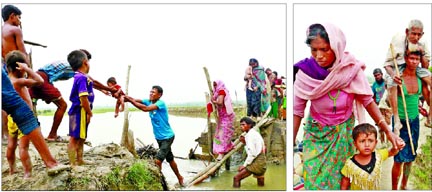
Staff Reporter :
About 300,000 Rohingyas could flee violence in northwestern Rakhine state of Myanmar to Bangladesh, a United Nations agency official said, warning of a funding shortfall for emergency food supplies for the refugees.
According to estimates issued by UN workers in Bangladesh’s border region of Cox’s Bazar, arrivals since the latest bloodshed started 12 days ago have already reached 146,000.
Numbers are difficult to establish with any certainty due to the turmoil as Rohingya escape operations by Myanmar’s military.
However, the UN officials have raised their estimate of the total expected refugees from 120,000 to 300,000, said Dipayan Bhattacharyya, who is Bangladesh spokesman for the World Food Programme.
“They are coming in nutritionally deprived, they have been cut off from a normal flow of food for possibly more than a month,” he told the media. “They were definitely visibly hungry, traumatised.”
The surge of refugees, many sick or wounded, has strained the resources of aid agencies and communities which are already helping hundreds of thousands displaced by previous waves of violence in Myanmar. Many have no shelter, and aid agencies are racing to provide clean water, sanitation and food.
Bhattacharyya said the refugees were now arriving by boats as well as crossing the land border at numerous points.
Another UN worker in the area cautioned that the estimates were not “hard science”, given the chaos and lack of access to the area on the Myanmar side where the military is still conducting its ‘clearance operation’.
Based on the prediction that 300,000 could arrive, the WFP calculated that it would need $13.3 million in additional funding to provide high-energy biscuits and basic rice rations for four months.
Bhattacharyya called for donors to meet the shortfall urgently. “If they don’t come forward now, we may see that these people would be fighting for food among themselves, the crime rate would go up, violence against women and on children would go up,” he said
Meanwhile, more eleven bodies of Rohingyas were recovered after two boats capsized in separate places in the Naf River on Thursday.
“Two boats each carrying 20 to 25 Rohingyas capsized in Tulatali and Shahparir Dwip areas under Teknaf upazila between 4:00am and 5:30am on Thursday,” Kanchan Kanti Das, Inspector of Baharchhara police outpost under Teknaf Police Station told journalists on Thursday.
He said police recovered the floating body of an 18-month-old baby from the Bay of Bengal in Shamlapur area.
“Ten more bodies of Rohingyas were recovered in coastal areas of the Bay of Bengal stretching from Shahparir Dwip to Baharchhara union of Teknaf upazila,” he added.
He said they were trying to enter Bangladesh following fresh violence in Rakhine state of Myanmar.
UNHCR spokesperson Vivian Tan on Thursday describes the desperation of refugees escaping violence in Myanmar.
“We were driving to a refugee camp when we passed this beach. We saw dozens of boats on the sea and people just streaming off them. These people were exhausted but they were also relieved. Some of them just collapsed on the beach,” he said.
“This was the most desperate and devastating thing I’ve seen in my 15 years of working with refugees. It reminded me of photos I’ve seen of Vietnamese boat people in the 1980s. But this is 30 years later. How can it be happening again?” he added.
The villagers who fled Myanmar’s Rakhine state said the soldiers came first, firing indiscriminately. Then came civilians, accompanying the soldiers, to loot and burn, according to agency.
Now in Bangladesh, 20 Muslims and Hindus gave interviews in which they recounted how they were forced out of their village of Kha Maung Seik in Myanmar’s Rakhine State on August 25.
“The military brought some Rakhine Buddhists with them and torched the village,” said Kadil Hussein, 55.
“All the Muslims in our village, about 10,000, fled. Some were killed by gunshots, the rest came here. There’s not a single person left.”
Hussein is staying with hundreds of other new arrivals at the Kutapalong refugee settlement, already home to thousands of Rohingya who fled earlier.
Nearly 150,000 Rohingya have arrived in Bangladesh since August 25, when insurgents of the Arakan Rohingya Salvation Army launched attacks on security forces in Rakhine state.
Myanmar says its forces are in a fight against “terrorists”. State media have accused Rohingya militants of burning villages and killing civilians of all religions.
Myanmar does recognize the 1.1 million Rohingya as citizens, labeling them illegal immigrants from Bangladesh.
Talking to media, the refugees from Kha Maung Seik, and from numerous other villages across the north of Rakhine state, say Myanmar forces and ethnic Rakhine Buddhists are intent on forcing them out.
One refugee, Body Alom, 28, said he hid in forest with thousands of others when the soldiers arrived. He waited for hours before emerging to look for his family.
He says he saw corpses in paddy fields, and eventually found his mother and brother dead with gunshot wounds. Two other villagers said they saw bodies in the fields.
“It wasn’t safe, so I just left them,” he said. “I had no chance to give them a burial.”
The main village of Kha Maung Seik was home to a mixed community, with Rohingya Muslims in the majority along with about 6,000 Rakhine Buddhists, Hindus and others.
Meanwhile, the Rohingya refugees have started building new homes in the plateau that sits in Jamtali area of Palangkhali union.
They were seen erecting structures mostly made with bamboos since Wednesday night. The remote plateau of Bagghuna under Ukhia upazila in Cox’s Bazar district, which was surrounded by small hills, now became busy place as Rohingyas have taken refuge there.
Hundreds of thousands of Rohingyas languishing in refugee camps and remote villages are nearing starvation.

